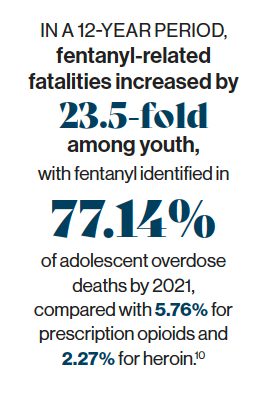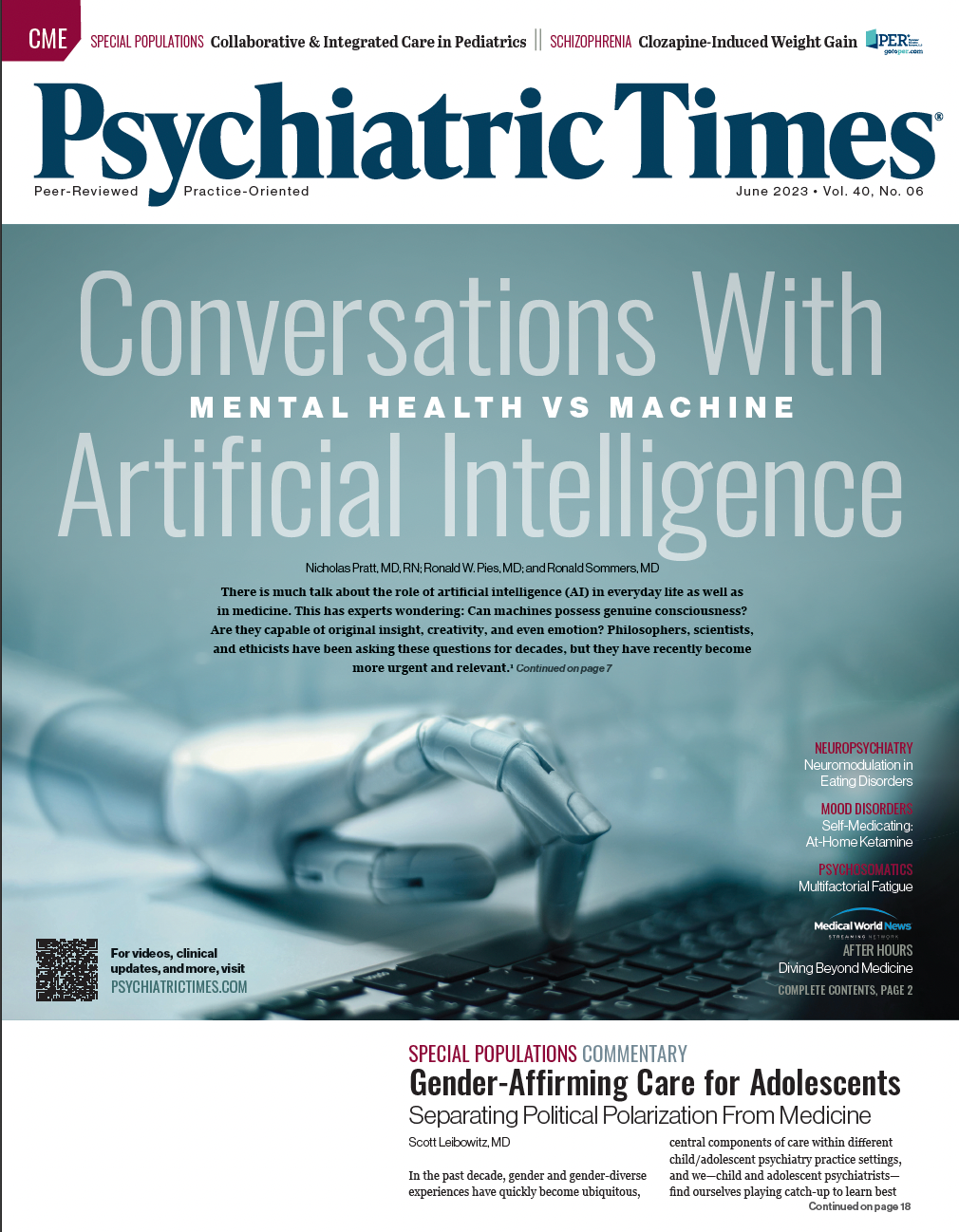Publication
Article
Psychiatric Times
Fentanyl: Accelerant of the Adolescent Opioid Crisis
Author(s):
How can we turn the tide of the fentanyl epidemic?
Vitalii Vodolazskyi_AdobeStock

SPECIAL REPORT: CHILD AND ADOLESCENT PSYCHIATRY
CASE VIGNETTE
“J.T.” is a 16-year-old cisgender male patient who was referred to an outpatient adolescent substance use treatment program after being treated at a local emergency department (ED) following his third fentanyl overdose requiring naloxone.
Per chart review, J.T. was observed in the ED until he began exhibiting signs of opioid withdrawal. He was then started on sublingual buprenorphine/naloxone (buprenorphine/naloxone-SL) using a standard, high-dose induction, with a total dose of 12/3 mg on day 1. J.T. was discharged with a 2-week prescription for buprenorphine/naloxone-SL 16/3 mg daily and a naloxone rescue kit.
J.T. first used fentanyl 4 months earlier. After smoking a pill he thought was Percocet at a friend’s party, he experienced an intense high and was hooked. A few days later, unable to achieve the same high with pills he had stolen from a relative, J.T. bought 3 blue pills from his friend. He used all 3 and remembered waking up in an ambulance on his way to the ED after his first opioid overdose.
He was defiant and noted to be argumentative with his parents in the ED. He was admitted to an inpatient psychiatric hospital with concern for suicidal behavior due to the severity of his overdose and parental report of a history of depression. He was discharged 5 days later, with a naloxone rescue kit and a referral to a community mental health center.
Over the following month, J.T. used fentanyl daily. He first experienced opioid withdrawal about 6 weeks ago when on a family vacation during which he was unable to obtain fentanyl. After returning from vacation, he thinks he experienced a second fentanyl overdose while smoking with his friend. He remembers his friend standing over him and panicking.
His friend told J.T. that he had passed out and he, the friend, had administered naloxone. J.T. pleaded with his friend not to call 911 or tell his parents because he did not want to be admitted to the hospital again. After this episode, J.T. tried to reduce his fentanyl use. He was able to go for about a day without using before again feeling sick with nausea, muscle aches, anxiety, and irritability. J.T. would then smoke a pill, and the withdrawal symptoms would resolve.
J.T. experienced his third overdose 2 weeks ago. It had been a particularly rough few weeks, and J.T. had been more irritable than usual when he would withdraw from fentanyl. He stopped going to school and isolated in his room. He just wanted to get high and feel good again. He does not remember how many blues he smoked but recalls waking up in the ED. While there, J.T. told his parents about his fentanyl use and that he felt trapped whenever he tried to quit and got sick.
Today, he reports that the buprenorphine/naloxone-SL has helped some. After a few days on the films, his fentanyl cravings became intense, and he smoked a blue. J.T. did not get high, so he stopped taking the buprenorphine/naloxone-SL.
He restarted the films about 2 days ago because of today’s appointment and since because he has been experiencing intense withdrawals. J.T. wants to be sober. He is worried about experiencing intense cravings and is not sure he will continue to take buprenorphine/naloxone-SL if they recur.
Increased Adolescent Overdose
Deaths from unintentional opioid overdose have risen at an unprecedented rate over the past decade, with extraordinarily broad geographic and sociodemographic reach. Although there has been a significant focus on the opioid epidemic among adults, adolescents and young adults have experienced a greater increase in overdose mortality than the general population.1
From 2010 to 2021, the annualized rate of drug overdose deaths among adolescents aged 14 to 18 years increased 2.3-fold, reaching a high of 5.49 per 100,000 youth.1 This sharp rise is primarily driven by the increased prevalence of illicitly manufactured fentanyl. During this same 12-year period, fentanyl-related fatalities increased by 23.5-fold among youth, with fentanyl identified in 77.14% of adolescent overdose deaths by 2021, compared with 5.76% for prescription opioids and 2.27% for heroin.1

Adolescents and young adults are more likely than older adults to be exposed to fentanyl and to seek out fentanyl as the opioid of choice.2,3 Fentanyl is also pervasive in the illicit drug market, often combined with oxycodone or other opioids, as well as nonopioid substances including benzodiazepines and methamphetamines in counterfeit pressed pills.4 As a result, many youth are exposed to fentanyl unintentionally and are at risk of fatal opioid dose with minimal prior opioid use.
Pharmacological Properties of Fentanyl
Fentanyl is a synthetic μ-opioid agonist whose features may contribute to its higher potential for misuse and risk of fatal overdose. Illicitly manufactured fentanyl exhibits variable and high potency that is approximately 50 to 100 times greater than that of heroin and morphine, respectively.5,6
In addition, its high lipophilicity leads to rapid crossing of the blood-brain barrier, with respiratory depression occurring within minutes of administration.5,6 Respiratory depression triggered by fentanyl and other opioids is mediated primarily via activation of opioid receptors in the pons. Fentanyl also induces chest wall rigidity and cardiac arrhythmias, which may contribute to its comparatively higher risk of fatal overdose.6
High lipophilicity also leads to rapid sequestration into adipose tissue, resulting in shorter duration of action. These characteristics contribute to the comparatively high misuse potential of fentanyl, which causes an explosive rush sensation, increased subjective positive reinforcing effects, and greater difficulty in decreasing use.6 Among individuals who misuse opioids, fentanyl also results in dose-related increases in positive reinforcers of misuse, including drug liking, good effects, and high.6
Overdose Prevention
It is essential for clinicians to implement substance use and overdose prevention strategies by early adolescence. Mental health clinicians and allied professionals should engage youth in a variety of settings, including primary care, school, and other clinical or community-based programs. Clinician-mediated interventions include routine substance use screening, preventive counseling, brief intervention, and referral to treatment if indicated.7
Education about the dangers of fentanyl is essential to reducing the risk of overdose. Youth should be counseled to never use illicit pills or street drugs and informed about the risk of fentanyl contamination of pressed pills and other drugs. For youth who do not intentionally use opioids, fentanyl test strips may be an effective harm reduction strategy to detect fentanyl contamination and change drug use behavior.8
Ultimately, all youth at risk of opioid overdose and their caregivers should be prescribed naloxone and taught how to respond to a potential overdose.9 Youth should be encouraged to never use fentanyl or other illicit drugs when they are alone so that naloxone may be administered and emergency services called in the event of a potential overdose.
Treatment of Opioid Use Disorder
Medications for opioid use disorder (OUD), integrated with psychotherapy, are the first-line treatment for youth with OUD.10-12 They are associated with reduced mortality, fewer relapses, enhanced recovery, and other health benefits.11
Cumulative evidence also demonstrates that the benefits of these medications far outweigh the risks of untreated OUD in youth.10 Nevertheless, medication use is lower among youth compared with adults, and most youth with OUD do not receive any pharmacotherapy.11
Sublingual buprenorphine/naloxone is FDA approved for treatment of OUD in adolescents 16 years and older, although it may be used off-label by clinicians in those under 16 years with moderate to severe OUD. One advantage of buprenorphine/naloxone is that it can be used in a variety of treatment settings, including acute care, inpatient, and outpatient primary care, mental health clinics, and substance use treatment programs.
Buprenorphine is generally well tolerated, with taste and constipation as common reasons for discontinuation. A partial opioid agonist, buprenorphine also has a lower potential risk of misuse and overdose compared with full agonists, including methadone.10
In response to the surging opioid epidemic, on December 29, 2022, the United States Congress eliminated the DATA Waiver (X-Waiver) Requirement, enabling all practitioners with a current DEA registration with Schedule III authority to prescribe buprenorphine for OUD, where not otherwise limited by state law.
Naltrexone, which is FDA approved for OUD in individuals 18 years and older, has also shown promise.10 An opioid antagonist, naltrexone requires that individuals abstain from short-acting opioids for at least 7 days and from long-acting opioids for up to 14 days prior to receiving the drug to avoid inducing opioid withdrawal.
As youth tend to struggle with opioid abstinence, in particular from fentanyl, naltrexone administration is challenging and may best be initiated in youth who are in restrictive settings or currently sober. In addition, although there are several regulatory and clinical barriers to its use, methadone may also be effective for youth with OUD,10 particularly those who have struggled to maintain abstinence on high-dose buprenorphine.
Future Directions
Achieving abstinence from illicit opioids has become an increasingly common clinical challenge among youth who misuse fentanyl. Further, with the rise of fentanyl, the risk of death among individuals not taking OUD medications has increased from 2.1 to 3.4 times greater than the risk for those taking medication.13
To date, relatively little is known about the effectiveness of medications for OUD among youth who use fentanyl. More recently, long-acting injectable formulations of buprenorphine and naltrexone have emerged as potential opportunities to increase medication adherence and treatment retention among youth and warrant further investigation.
Furthermore, it is vital to design treatment programs that integrate medications for OUD with therapeutic interventions to address other motivators for substance use and increase treatment retention.10,12
Perhaps most significantly, public awareness of the dangers of fentanyl is increasing, particularly among youth, and evidence-based medications for OUD are becoming more accepted. Mental health clinicians should proceed with a sense of urgency and optimism to expand prevention initiatives, naloxone distribution, and availability of evidence-based treatments to turn the tide of the fentanyl epidemic.
Dr Hinckley is codirector of the Addiction Biology Lab and director of Adolescent Psychiatric Services and Addiction Research and Treatment Services at University of Colorado School of Medicine.
References
1. Friedman J, Godvin M, Shover CL, et al. Trends in drug overdose deaths among US adolescents, January 2010 to June 2021. JAMA. 2022;327(14):1398-1400.
2. Macmadu A, Carroll JJ, Hadland SE, et al. Prevalence and correlates of fentanyl-contaminated heroin exposure among young adults who use prescription opioids non-medically. Addict Behav. 2017;68:35-38.
3. Bohm MK, Clayton HB. Nonmedical use of prescription opioids, heroin use, injection drug use, and overdose mortality in U.S. adolescents. J Stud Alcohol Drugs. 2020;81(4):484-488.
4. O’Donnell J, Tanz LJ, Gladden RM, et al. Trends in and characteristics of drug overdose deaths involving illicitly manufactured fentanyls - United States, 2019-2020. MMWR Morb Mortal Wkly Rep. 2021;70(50):1740-1746.
5. Han Y, Yan W, Zheng Y, et al. The rising crisis of illicit fentanyl use, overdose, and potential therapeutic strategies. Transl Psychiatry. 2019;9(1):282.
6. Comer SD, Cahill CM. Fentanyl: receptor pharmacology, abuse potential, and implications for treatment. Neurosci Biobehav Rev. 2019;106:49-57.
7. Nelson LF, Weitzman ER, Levy S. Prevention of substance use disorders. Med Clin North Am. 2022;106(1):153-168.
8. Peiper NC, Clarke SD, Vincent LB, et al. Fentanyl test strips as an opioid overdose prevention strategy: findings from a syringe services program in the Southeastern United States. Int J Drug Policy. 2019;63:122-128.
9. Chadi N, Hadland SE. Youth access to naloxone: the next frontier? J Adolesc Health. 2019;65(5):571-572.
10. Camenga DR, Colon-Rivera HA, Muvvala SB. Medications for maintenance treatment of opioid use disorder in adolescents: a narrative review and assessment of clinical benefits and potential risks. J Stud Alcohol Drugs. 2019;80(4):393-402.
11. Society for Adolescent Health and Medicine. Medication for adolescents and young adults with opioid use disorder. J Adolesc Health. 2021;68(3):632-636.
12. Hammond CJ, Kady A, Park G, et al. Therapy dose mediates the relationship between buprenorphine/naloxone and opioid treatment outcomes in youth receiving medication for opioid use disorder treatment. J Addict Med. 2022;16(2):e97-e104.
13. Pearce LA, Min JE, Piske M, et al. Opioid agonist treatment and risk of mortality during opioid overdose public health emergency: population based retrospective cohort study. BMJ. 2020;368:m772.







